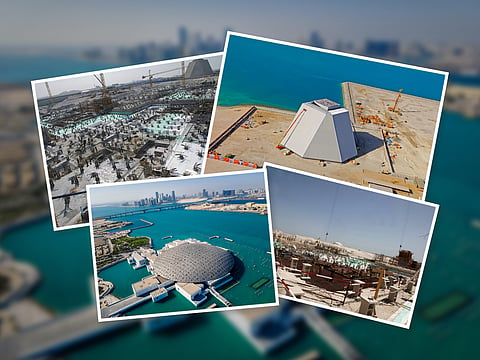Louvre Abu Dhabi, from construction to present day: Journey in timelapse
The museum is home to a world-class permanent collection that spans thousands of years

Dubai: Nearly two decades ago, the shimmering sands of Saadiyat Island bore witness to the first steps of what would become one of the Arab world's most significant cultural landmarks—Louvre Abu Dhabi.
Conceived through a landmark agreement between the UAE and France in 2007, the museum officially opened its doors to the world on November 11, 2017. Today, in 2025, it stands not only as a masterpiece of architecture but also as a powerful symbol of cross-cultural dialogue and artistic legacy.
Designed by Pritzker Prize-winning architect Jean Nouvel, the museum's most iconic feature—the floating dome—remains as mesmerising today as it was when it was first unveiled. Composed of 7,850 unique metal stars, the 180-meter-wide dome creates a stunning "rain of light," a pattern of sunlight and shadow inspired by traditional Arabic architecture.
Louvre Abu Dhabi celebrates the universal creativity of humanity and invites audiences to see humanity in a new light. Through its innovative curatorial approach, the museum focuses on building understanding across cultures: through stories of human creativity that transcend civilisations, geographies, and times.
The museum’s growing collection is unparalleled in the region and spans thousands of years of human history, including prehistoric tools, artefacts, religious texts, iconic paintings, and contemporary artworks. The permanent collection is supplemented by rotating loans from 19 French partner institutions and regional and international museums. Louvre Abu Dhabi is a testing ground for new ideas in a globalised world and champions new generations of cultural leaders. Its international exhibitions, programming and Children’s Museum are inclusive platforms that connect communities and offer enjoyment for all.
The museum is home to a world-class permanent collection that spans thousands of years, showcasing artefacts and artworks from ancient civilisations to contemporary masters. Highlights include a Bactrian Princess from Central Asia (c. 2000 BCE), a rare Quranic manuscript, Leonardo da Vinci's "La Belle Ferronnière", and works by Van Gogh, Monet, and Ai Weiwei.
Over the years, Louvre Abu Dhabi has evolved beyond a museum—it's now a living cultural hub. From international exhibitions and educational programmes to VR art experiences and sustainability-focused initiatives, it continues to redefine what a museum can be.
Since opening, it has welcomed over 5 million visitors, becoming a must-see destination for residents, tourists, and scholars alike. In 2024, it was named one of the "Top 10 Museums to Visit in the World" by National Geographic.
As the museum looks ahead to future expansions—including a children's museum wing and new regional collaborations—its roots remain firmly grounded in a vision of unity through art.
From a bold dream in the desert to a beacon of global heritage, Louvre Abu Dhabi continues to inspire generations, one masterpiece at a time.
Courtesy for Time-Lapse: EarthCam’s award-winning 4K Time-Lapse for the Louvre Abu Dhabi museum.
Sign up for the Daily Briefing
Get the latest news and updates straight to your inbox



